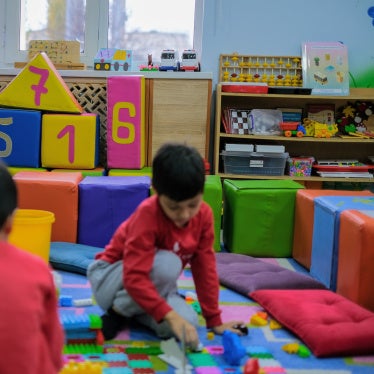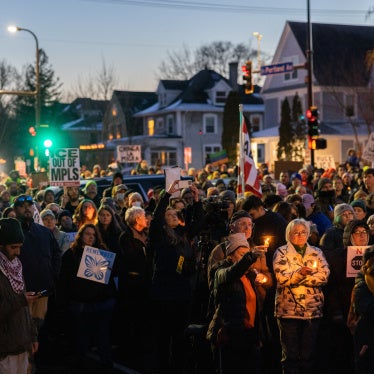WHAT PROBLEM IS BEING ADDRESSED?
An estimated 250,000 children are exploited each day in state-run armies, paramilitaries and guerilla groups around the world. Called “child soldiers,” they serve as combatants, porters, human mine detectors and sex slaves. Their health and lives are endangered and their childhoods are sacrificed.
WHAT IS THE GOAL AND STRATEGY OF THE BILL?
The bill is designed to encourage governments to disarm, demobilize, and rehabilitate child soldiers from government forces and government-supported paramilitaries. Using the Department of State’s Country Reports on Human Rights as a barometer, this bill would restrict the provision of U.S. International Military Education and Training, Foreign Military Financing, and other defense-related assistance in our foreign operations programs for countries in violation of the bill’s standards. Countries that are clearly identified in the Human Rights Report as recruiting or using child soldiers in government armed forces or government-supported paramilitaries or militias in violation of international standards would be eligible only for military assistance to address the issue of child soldiers or otherwise professionalize their armed forces until the problem is remedied.
WHY?
U.S. military assistance should not go to finance the use and exploitation of children in armed conflict. Such practices directly contravene U.S. policy, practice and the Optional Protocol to the Convention on the Rights of the Child on the Involvement of Children in Armed Conflict, which the United States ratified in 2002. It is also in the US’ national security interest to reduce the incidence of child soldiers in the world: commanders do not want their troops to confront the specter of an armed child in a combat situation.
Children suffer higher mortality, disease, and injury rates in combat situations than adults. The lasting effects of war and abuse may also remain with them long after the shooting stops. Both girls and boys may be stigmatized and traumatized by their experience and left with neither family connections nor skills to allow them to transition successfully into productive adult lives. This bill will both underscore the importance of the issue within United States foreign policy and provide concrete means to help countries end their reliance on children as soldiers.
WHAT ASSISTANCE PROGRAMS ARE INVOLVED?
Foreign Military Sales (FMS), Direct Commercial Sales (DCS), Excess Defense Articles (EDA), International Military Education and Training (IMET), and Foreign Military Financing (FMF).
WHAT COUNTRIES MAY BE AFFECTED?
Afghanistan, Burundi, Chad, Colombia, Congo (Democratic Republic of), Cote d’Ivoire, Sri Lanka, Sudan and Uganda. These countries were identified in the 2006 State Department human rights reports as having child soldiers in government forces or government-linked militias. They also receive at least one form of US military assistance.
DOES THE BILL AUTOMATICALLY CUT OFF US MILITARY ASSISTANCE?
The bill will not automatically cut off aid to countries that are identified by the State Department as using or tolerating child soldiers. Countries that are seeking to implement demobilization measures would be eligible for assistance in that process and in the professionalization of their armed forces for up to two years before prohibitions on assistance would be imposed. Moreover, the bill provides the President with the authority to waive restrictions if he determines that such a waiver is in the national interest.
HOW DOES THE BILL DEFINE A CHILD SOLDIER?
In this Act, the term ‘‘child soldier’’ means
- 1) any person under age 18 who takes a direct part in hostilities as a member of governmental armed forces;
2) any person under age 18 who has been compulsorily recruited into governmental armed forces;
3) any person under age 16 voluntarily recruited into governmental armed forces;
4) any person under age 18 recruited or used in hostilities by armed forces distinct from the armed forces of a State;
5) persons identified in 2, 3, and 4 may be serving in any capacity, including in support roles such as, but not limited to, cooks, porters, messengers, medics, guards, sex slaves, etc.
This definition is based on the Optional Protocol to the Convention on the Rights of the Child, ratified by the United States in December 2002.
WHAT HAS CONGRESS PREVIOUSLY SAID ABOUT CHILD SOLDIERS?
Both chambers of the United States Congress have made clear their position on this issue in recent years as articulated in a series of resolutions, “Expressing condemnation of the use of children as soldiers and the belief that the United States should support and, where possible, lead efforts to establish and enforce international standards designed to end this abuse of human rights” (S. CON. RES. 72, H. CON. RES. 348, H. CON. RES. 209, H. CON. RES. 309, H. CON. RES. 202). In addition, the Congress now requires that the U.S. Department of State monitor and report on this problem in their annual report on human rights practices.
WHAT TREATIES RELATED TO CHILD SOLDIERS IS THE U.S. PARTY TO?
The United States is a party to the Optional Protocol to the Convention on the Rights of the Child on the Involvement of Children in Armed Conflict (ratified by the U.S. in 2002), which sets 18 as the minimum age for forced recruitment or participation in hostilities, and ILO Convention 182 on the Worst Forms of Child Labor (ratified in 1999), which defines the forced recruitment of children under the age of 18 for use in armed conflict as one of the worst forms of child labor.








